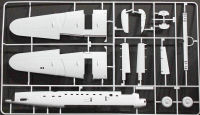
Airfix 1/72 Avro Lancaster B.II Kit First Look
By Michael Benolkin
| Date of Review | July 2013 | Manufacturer | Airfix |
|---|---|---|---|
| Subject | Avro Lancaster B.II | Scale | 1/72 |
| Kit Number | 8001 | Primary Media | Styrene |
| Pros | First production B.II kit in any scale | Cons | Nothing noted |
| Skill Level | Experienced | MSRP (USD) | $34.99 |
First Look
 |
 |
 |
 |
 |
 |
 |
The Avro Lancaster is the iconic RAF bomber of World War II, though most folks are familiar with the Merlin-powered variants that can be seen in museums around the world as well as the few airworthy examples operating with the Battle of Britain Memorial Foundation and one in Canada. During the early stages of Lancaster production, strategic planners were concerned about the limitations of Rolls Royce to produce sufficient engines to satisfy Spitfire, Mosquito, as well as Lancaster demands. Avro developed the B.II variant powered by the Bristol Hercules radial engine as an alternative to the Merlin. In all, 300 B.IIs were produced before sufficient quantities of American-built Packard Merlins were available (which also powered the P-51B/C/D/K Mustang) to render the B.III.
The RCAF was allocated most of the B.II Lancasters because they were replacing the Wellington and Hampden bombers, both of which were also radial-engine powered and made maintenance transition easier. While the B.II was as fast as the B.I, it had a better rate of climb but a significantly lower service ceiling. In combat operations, nearly 60% of the B.IIs were lost, but they provided an essential augmentation to the RAF night bomber force.
Here is the very first full-kit (not a conversion) in styrene of the Lancaster B.II. This is Airfix's latest release and I must say that the detailing is spectacular. The kit is molded in light gray styrene and presented on six parts trees plus one tree of clear parts. The surface detailing on the wings and fuselage are finely scribed and while there are quite a few small parts (hence the experienced skill level recommendation), the kit is not over-engineered.
Construction looks very straightforward though it will not be a weekend project. There are 22 pages in the instruction book and over 100 steps. Don't let this intimidate you, the steps are well-diagramed and each step is not complicated. With a little patience and care, you'll have one of the best Lancaster models in this scale (with the Airfix B.III no-doubt in the same category).
Among the features and options in this kit:
- Detailed flight deck
- Optional seated pilot figure
- Detailed bombardier station in nose
- Navigator station behind pilot
- The wing/fuselage join is assisted with mainspars that interconnect the wings
- The outboard sections of the mainspars also serve as front/rear bulkheads for the main wheel wells
- Sides of main wheel wells are open ribs revealing details inside the wings
- Choice of ventral gun turret installed or faired over
- Positionable elevators
- Positionable rudders
- Positionable ailerons
- Positionable flaps
- Positionable landing gear (optional in-flight display stand mounting holes in bomb bay
- Weighted main gear tires
- Positionable bomb bay doors
- Choice of step-bulge or gentle-bulged bomb bay doors
Markings are provided for two examples:
- B.II, DS842, 514 Sqn, JI-F, 'Fanny Ferkin II', RAF, 1944
- B.II, LL725, 408 Sqn, EQ-Z, 'Zombie', RCAF, 1944
This is a very nicely engineered model from Airfix and rivals many other model companies in its molding, detailing, and assembly breakdown, all while avoiding the temptation to over-engineer the model (putting details where you'd never see them after assembly). You'll definitely want to get one of these in your project queue!
My sincere thanks to Hornby USA for this review sample!







